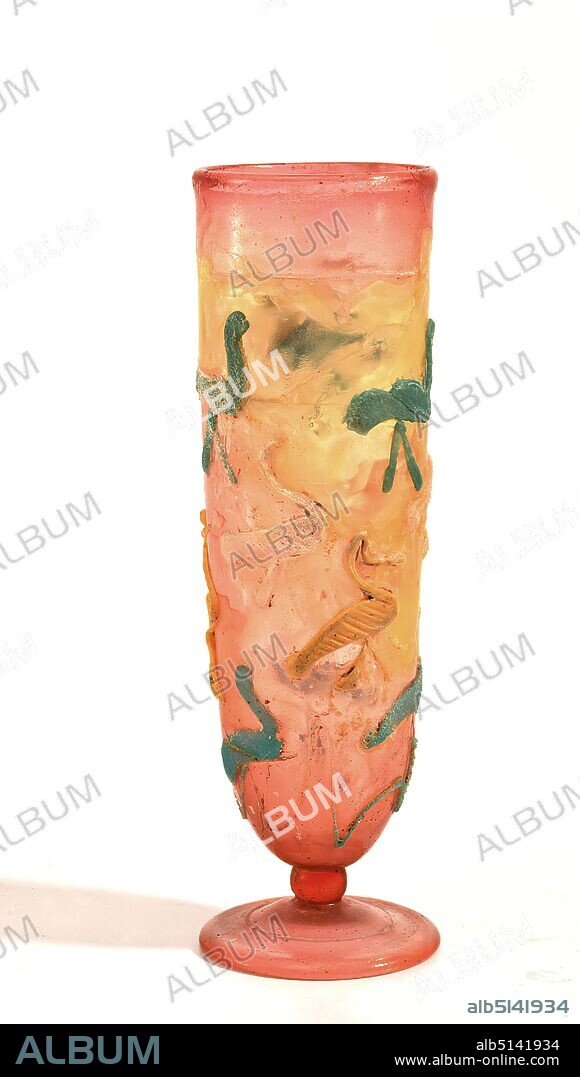alb5141934
Goblet (Cranes), glass, overlaid, thread support, cut, glass, Total: Height: 17.4 cm; Diameter: 5.2 cm; Base diameter: 5.3 cm, drinking and barware, birds, The slender goblet with cylindrical vessel body tapering at the bottom, flattened spherical mode and conical base is composed of numerous fragments. Minor missing parts are replaced. Its decoration is particularly captivating: birds in opaque glass are applied to the thin-walled, light pink tinted transparent glass. Three birds with long, curved necks and beaks, each with a long, bent neck and beak, stride out to the right in four staggered rows. Due to their appearance, they are probably herons or cranes. Their plumage is indicated by grooves created with a stamp. The birds of the upper and lower row are turquoise-blue, the second and third row white above and yellow below. The lower conclusion forms put on turquoise-blue snake-threads. The coloration and opacity of the birds stands in clear contrast to the transparency and lightness of the vessel body, whose color is unusual. Although high-quality productions of snake-string glasses are known and typical especially from the Roman Cologne (Colonia Claudia Ara Agrippinensium), this goblet - due to its type and decoration - might rather be assigned to an eastern, probably Syrian production, which should remain an important region of glass production far beyond the late antiquity. Earliest examples of snake-string glasses in the west of the Imperium Romanum date to the 2nd half of the 2nd century AD, so that a similar dating can be assumed for this vessel. Herons or cranes in marshlands are a common motif in Roman art since the early imperial period. They can be found on silver magnificent cups from the house of Menander in Pompeii, on an Arretine Terra Sigillata chalice, clay lamps or mosaics, for example in Italica (Spain). A wall painting from the House of Epigrams in Pompeii shows a heron standing in front of an erect cobra with its shield spread out in front o.

|
Añadir a otro lightbox |
|
Añadir a otro lightbox |



¿Ya tienes cuenta? Iniciar sesión
¿No tienes cuenta? Regístrate
Compra esta imagen
Descripción:
Ver traducción automática
Goblet (Cranes), glass, overlaid, thread support, cut, glass, Total: Height: 17.4 cm; Diameter: 5.2 cm; Base diameter: 5.3 cm, drinking and barware, birds, The slender goblet with cylindrical vessel body tapering at the bottom, flattened spherical mode and conical base is composed of numerous fragments. Minor missing parts are replaced. Its decoration is particularly captivating: birds in opaque glass are applied to the thin-walled, light pink tinted transparent glass. Three birds with long, curved necks and beaks, each with a long, bent neck and beak, stride out to the right in four staggered rows. Due to their appearance, they are probably herons or cranes. Their plumage is indicated by grooves created with a stamp. The birds of the upper and lower row are turquoise-blue, the second and third row white above and yellow below. The lower conclusion forms put on turquoise-blue snake-threads. The coloration and opacity of the birds stands in clear contrast to the transparency and lightness of the vessel body, whose color is unusual. Although high-quality productions of snake-string glasses are known and typical especially from the Roman Cologne (Colonia Claudia Ara Agrippinensium), this goblet - due to its type and decoration - might rather be assigned to an eastern, probably Syrian production, which should remain an important region of glass production far beyond the late antiquity. Earliest examples of snake-string glasses in the west of the Imperium Romanum date to the 2nd half of the 2nd century AD, so that a similar dating can be assumed for this vessel. Herons or cranes in marshlands are a common motif in Roman art since the early imperial period. They can be found on silver magnificent cups from the house of Menander in Pompeii, on an Arretine Terra Sigillata chalice, clay lamps or mosaics, for example in Italica (Spain). A wall painting from the House of Epigrams in Pompeii shows a heron standing in front of an erect cobra with its shield spread out in front o
Personas:
Crédito:
Album / quintlox
Autorizaciones:
Modelo: No - Propiedad: No
¿Preguntas relacionadas con los derechos?
¿Preguntas relacionadas con los derechos?
Tamaño imagen:
2448 x 4320 px | 30.3 MB
Tamaño impresión:
20.7 x 36.6 cm | 8.2 x 14.4 in (300 dpi)
Palabras clave:
AMARILLO • APOLO (DIOS) • ARIADNA • ARTE ROMANO • ASOCIADO • AVES • BAILE • BEBER • BUQUE • CASA • CASAS • CAZA • COLOR • COLORACION • CORTADA • CORTAR • CORTE • CUARTELES DE INVIERNO • CULO • DECORACION • DELOS • DEMETER • DIAMETRO • EJEMPLO • EN • ENTENDER • EPOCA HELENISTICA • ESCRITURA GRIEGA • ESPAÑA • FECUNDIDAD • FERTILIDAD FECUNDIDAD • FERTILIDAD • FONDO NEGRO • FRESCO • FRONTAL • GRACIAS • GREEK • GRIEGO • GRUAS • HELENICO • HELENISTICO • HOMERO • INDICO • INUSUAL • ISLA DELOS • ITALICA • LIGEREZA • LUCHA • LUZ • MANO • MIGRADO • MITO • MOSAICS • MURAL • ODISEA • ODISEA, HOMERO • OESTE • OPACIDAD • ORIENTAL • PAISAJE • PAISAJES • PERIODO • PICO • PINTURA AL FRESCO • PINTURA EN PARED • PINTURA MURAL • PLUMAJE • POMPEYA • POZO • PRIMAVRWEA • REPRESENTACIONES • SABIDURIA • SALIR • SEGUNDO • SIMBOLO • SOL • SPAIN • SUGIRIÓ • TALAR • TALLA • TESEO • TIEMPO • TIPICO • TRANSPARENCIA • VIDRIO • VIGILANCIA • VINCULADOS
 Pinterest
Pinterest Twitter
Twitter Facebook
Facebook Copiar enlace
Copiar enlace Email
Email
